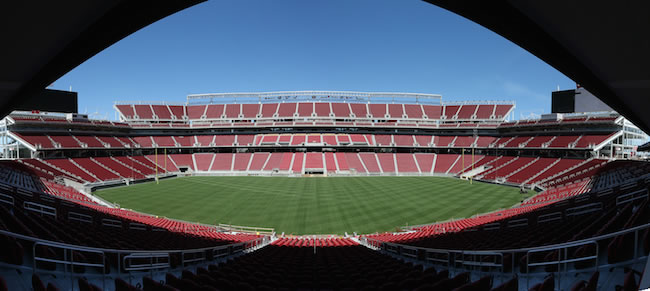While it seldom rains in sunny California, when it does, it pours. But San Francisco 49ers’ fans visiting the National Football League’s (NFL) new ecofriendly Levi’s Stadium in Santa Clara, California will have the opportunity to reap the benefits of American Hydrotech Inc.’s Monolithic Membrane 6125 (MM6125) and the Hydrotech Garden Roof Assembly, which created a green, living rooftop that helps cool the stadium.
“By integrating a hardscape space with the vegetated roof, the stadium was able to accomplish several goals: a first-class amenity deck that also provides stormwater management benefits,” says Dennis Yanez, American Hydrotech national marketing manager. He notes that his company offers design teams, engineers, and landscape architects full, project-specific documentation to assess roof contributions to meeting both municipal and LEED stormwater requirements.
A total of 426,000 square feet of MM6125 Hot Fluid Rubberized Asphalt was used to waterproof the 350,000-square-foot concourse and 60,000 square feet of below-grade applications, as well as the garden roof and amenity deck.
This 68,500-seat stadium sports unparalleled sustainable design and technologies. Touted as the first “next generation” sports facility to come online, Levi’s Stadium has garnered awards recognizing its sustainable features, including the 2014 Forest Stewardship Council Leadership Award, 2014 WateReuse Customer of the Year Award, and American Institute of Architects Kansas City 2014 Merit Award—Sports Venue. It is also the first pro-football stadium that the US Green Building Council has certified as LEED Gold.
“We wanted this to be the ‘best of the best’ with respect to environmental sustainability,” says Jack Hill, 49ers project executive for the stadium development. “California codes are stringent, and a lot of what we did exceeds California’s building standards and LEED (Gold) standards.”

The 25,000-square-foot American Hydrotech Garden Roof Assembly is a lightweight green technology that supports a living garden of drought-tolerant indigenous plants.
A GARDEN ROOF IS A BOOST TO NET-ZERO ENERGY
The stadium design takes sustainability to a new level for sports facilities, with every facet of operations aimed at energy and water efficiency or involving clean/green technologies, materials, and processes.
The stadium’s impressive, state-of-the-art photovoltaic system, which includes three solar-array covered bridges, and a solar canopy above the 18,000-square NRG Solar Terrace over a tower with 9,000 luxury suites, produces more energy than is used during games.
A feature that boosts the solar system’s ability to achieve net-zero energy status is the 25,000-square-foot American Hydrotech Garden Roof Assembly, a lightweight green technology that supports a living garden of drought-tolerant indigenous plants, as well as 23,000-square-feet of Ultimate Assembly pavers that help create an inviting deck space for fans to gather and socialize while enjoying the game.
“Pavers installed in an open joint configuration that can be set level on fixed-height and adjustable pedestals, regardless of the slope at the level below,” Yanez explains.
“This allows water to drain off the paver surface and quickly flow to concealed drains below.”
This green rooftop and amenity deck offers fans an aesthetically beautiful, therapeutic, and peaceful environment, but most importantly it reduces stormwater runoff—typically catching 50 to 90% of rainfall— and heat gain on the roof, boosting energy efficiency to decrease energy use. Cooling the rooftop helps regulate the building’s indoor ambient temperature and eliminates unhealthy effects associated with the “urban heat island” phenomenon on hot days, improving air quality by processing toxins and re-oxygenating air.
The urban heat island effect creates a heat dome that traps air pollution and smog and raises indoor air temperature, resulting in poor air quality and higher energy demand and costs to cool a building.

The green rooftop and amenity deck offers fans an aesthetically pleasing environment but also reduces stormwater runoff, catching 50 to 90% of rainfall.
IT’S ALL ABOUT THE FANS AND THEIR CULTURE
Levi’s Stadium is designed to provide fans the best experience possible. The 49ers’ owner and co-chair John York and CEO Jed York wanted an open, transparent design that allows fans to stay connected to

Ample bike parking is available at the stadium, and certain park-
ing lots even offer bicycle valet services.
the game from all points within the stadium, from concessions to premium club and concourse areas, notes Timothy Cahill, vice president and national director for design at Kansas City, Missouri-based HNTB Companies, the stadium architect. He says it was also their idea to stack the 9,600 luxury suites in a tower on one side and majority of club seats in the lower bowl in order to keep fans close to the action.
They wanted the stadium to incorporate 49ers tradition and branding, but also to reflect California and its culture, Cahill continues. “It’s in the Silicon Valley, so it needed to suggest the region’s food and wine culture and have the highest level of technology and sustainability [available].”
Hill concurs, noting that the concession contractor serves only healthy and organic food options, as well as exclusively offers regionally produced wines, because that “was the responsible thing to do.”


